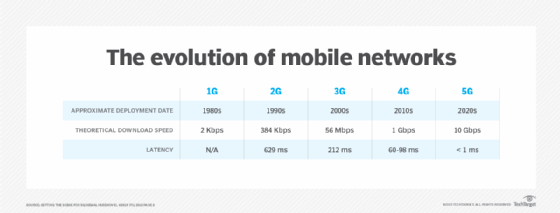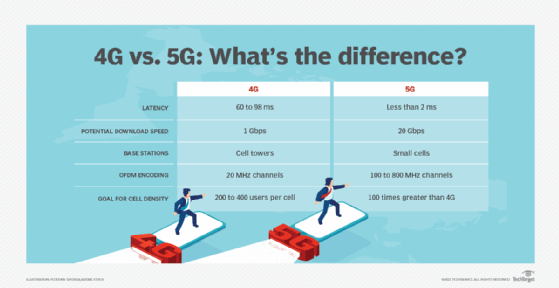5G vs. 4G: Learn the key differences between them
5G and 4G network architectures have some significant differences. See how the two technologies differ and what the new capabilities mean for business communications.
In a perfect world, each generation improves upon the best qualities of its predecessors and thrives in ways previous generations couldn't. Often, new generations also respond to the issues created by older generations. This is particularly true for generations of mobile networking and cellular technology.
4G, the fourth generation of mobile networking, offers speeds of up to 100 Mbps. It supports high-bandwidth applications and capabilities like high-definition streaming, video conferencing and remote work.
5G, the latest generation of mobile networking, surpasses 4G network capabilities and exceeds 4G's goals for general speeds, latency and density. 5G offers significantly faster speeds, up to 100 times faster than 4G, typically up to 1 Gbps, and supports advanced use cases, such as AI applications and edge computing.
Organizations should understand the differences between 4G and 5G network architectures to determine how the use of one technology over another could affect business operations.
What is 4G and how does it work?
4G is the fourth generation of cellular network technology and 5G's predecessor. Like all types of cellular connectivity, 4G operates via a radio system: A base station emits radio frequency signals between the network and 4G-capable devices. This process is similar to how previous generations of cellular technology operate, but 4G improves on its predecessors by offering benefits of faster speeds, better spectral efficiency and higher network capacity.
Some of 4G's benefits include enhanced cell density, improved VoIP capabilities and greater bandwidth. These features enabled 4G to serve as the most innovative generation of cellular technology in the 2010s and reach ubiquity within the decade.
The LTE wireless broadband standard developed during 4G's prominence and helped 4G deliver on its potential for faster speeds and improved network reliability. Early LTE deployments helped bridge the technology gap between 3G and true 4G. The two frequently come as a package -- i.e., 4G LTE -- because LTE is the most common technology standard used to implement 4G networks. 4G LTE enables a variety of capabilities that previous generations of mobile networking don't support, including the following:
- Supports various traffic types, such as voice, video and data.
- Uses IP-based communication methods for all traffic types.
- Uses carrier aggregation and orthogonal frequency-division multiple access to enable multiple devices to share available bandwidth effectively.
The 4G era saw the innovation of various networking trends, such as IoT growth, greater numbers of smartphones, and remote and mobile workforces. These trends advanced throughout the 2010s, which created a need to support faster speeds and greater cell density.
4G is still in use by millions of users around the world. According to a December 2024 report from 5G Americas and Informa TechTarget's Omdia, 5G usage will surpass 4G connections in North America in 2025, while 4G will remain the dominant wireless connectivity option throughout the rest of the world.
Mobile network operators (MNOs) continue to maintain their 4G networks to serve those on the standard. This interoperability enables operators to bridge the digital divide for users still on legacy network standards, while carriers roll out 5G networks and customers transition to the new standard.
What is 5G and how does it work?
5G is the latest generation of cellular network technology. As with 4G and previous generations, 5G cell towers use radio waves to connect devices to network infrastructure and transmit data between them. What sets 5G apart from previous generations is its broader use of radio frequencies, even faster speeds, network slicing and other capabilities.
5G base stations use advanced technologies -- such as network slicing, orthogonal frequency-division multiplexing (OFDM) and massive multiple input, multiple output -- to provide faster connections and improve overall network performance.
Standalone (SA) 5G infrastructure includes a 5G radio access network, a 5G core and 5G-compatible devices. This is the ultimate, true form of 5G that fulfills its full potential with network slicing and ultralow latency. Non-standalone (NSA) 5G uses existing 4G LTE infrastructure and a 4G core as carriers build out their SA 5G network infrastructure. This enables carriers to operate in a hybrid mode between NSA and SA 5G as they complete their rollouts.
While NSA 5G infrastructure uses the LTE standard, it also introduces another standard called 5G New Radio (5G NR) that aims to replace LTE. NR is to 5G as LTE is to 4G -- it's the radio access technology standard that improves 5G connectivity and enables it to offer faster speeds, lower latency, greater capacity and more. 5G NR builds off LTE's best capabilities and brings new benefits.
Benefits of 5G include the following:
- Increased energy savings for connected devices.
- Enhanced connectivity.
- Faster network speeds.
- Real-time communication capabilities.
5G can also operate on a new high-frequency spectrum -- millimeter wave (mmWave) -- which uses wavelengths between 30 GHz and 300 GHz, compared to 4G LTE's wavelengths of under 6 GHz. Due to the mmWave spectrum, 5G requires new small-cell base stations to operate and function.
5G's improved capabilities enable operators to provide connectivity that supports next-generation wireless network infrastructures. Most MNOs are still far away from realizing these goals, however. While many rolled out small, early 5G deployments in the late 2010s, they are still developing their 5G infrastructure.
Compare 4G vs. 5G: Latency, speed and bandwidth
The main differences between 4G and 5G come down to the improved capabilities 5G provides over 4G. Latency, speed and bandwidth are some of the most important performance indicators of any network. As the most recent mobile network technology standard, 5G improves upon these aspects by wide margins compared to 4G.
The major differences between 4G and 5G include the following:
- Latency.
- Potential download speeds.
- Base stations.
- OFDM encoding.
- Cell density.

Latency
One of the biggest differences between 4G and 5G is latency, with 5G providing lower latency. SA 5G can offer latency under 5 milliseconds, while 4G latency ranges from 20 ms to 40 ms. Lower latency brings advancements in other areas, such as enhanced responsiveness and network efficiency.
Potential download speeds
5G builds upon and enhances promises of quick potential download speeds. 4G's download speeds typically reach up to 20 Mbps to 100 Mbps. 5G maximum download speeds can reach between 10 Gbps and 20 Gbps in ideal conditions using mmWave technology but are typically closer to 1 Gbps to 3 Gbps.
Base stations
Another key difference between 4G and 5G is the base station required to transmit signals. Like its predecessors, 4G transmits signals from cell towers. However, 5G uses small-cell technology, due to its faster speeds and mmWave frequency bands. Carriers deploy high-band 5G in small cells about the size of pizza boxes in multiple locations. 5G still uses cell towers for its lower-frequency spectrums as well.
Carriers must deploy small cells in various areas due to the mmWave frequency. While the frequency is higher than cellular technology has seen so far, mmWave has weaker signals that travel across shorter distances. Small-cell stations must be placed frequently in 5G-capable areas to ensure the signals reach users and businesses.
OFDM encoding
OFDM splits a wireless signal into multiple, narrower frequency channels -- called subcarriers -- within the same bandwidth to avoid interference. Each subcarrier can carry its own piece of the total data, which improves data throughput and bolsters 4G and 5G download speeds. 4G LTE typically uses 1.4 MHz to 20 MHz channels, while 5G uses 100 MHz to 800 MHz channels when using mmWave.
Cell density
Small-cell technology enables 5G to increase cell density and enhance network capacity. While 4G also promised improved speeds and capacity, it didn't completely meet its high goals for high-speed requirements. 5G succeeds where its predecessor fell short, increasing density to support more users and connected devices, which leads to increased mobile device and connection capacity.

4G-to-5G transition considerations
4G is still available for use, but technology experts recommend that enterprises switch to 5G when possible. Beyond the faster speeds and lower latency, 5G is more reliable and secure than 4G. Its capabilities are especially suited to support industries that require real-time communication, high density and low latency, such as healthcare, manufacturing, autonomous vehicles and fixed wireless access.
5G is still in development, but businesses and consumers can adopt the technology now. Its availability largely depends on location, however. For example, according to 5G Americas and Omdia, 5G reaches 70% of the population in North America.
Access to 5G also depends on carrier availability. Most major MNOs in North America have rolled out SA 5G deployments, but some MNOs still have NSA 5G deployments. NSA 5G is an improvement over 4G LTE -- it reduces latency and offers faster speeds compared to the latter -- but it isn't the full version of 5G.
NSA 5G also serves as a bridge from 4G LTE to 5G. This method of 5G deployment lets MNOs implement 5G capabilities on their current 4G infrastructure. Early 5G adopters looked to NSA 5G as they transitioned from legacy cellular technology to 5G. Many MNOs now have SA 5G deployments available, but those that have yet to build a full-fledged 5G network can use NSA 5G as a starting point to move from 4G to 5G.
Editor's note: This article was originally published by Michaela Goss and updated by Deanna Darah to reflect industry changes and improve reader experience.
Michaela Goss is senior site editor for Informa TechTarget's Customer Experience and Content Management sites. She joined TechTarget as a writer and editor in 2018.
Deanna Darah is site editor for Informa TechTarget's Networking site. She began editing and writing at TechTarget after graduating from the University of Massachusetts Lowell in 2021.






